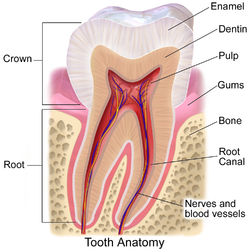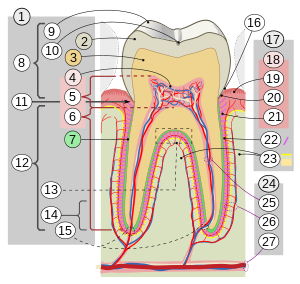Anatomy of the Crown
- Tooth
- Enamel
- Dentin
- Dental pulp
- Cameral pulp
Structures Related to the Crown
- Root pulp
- Cementum
- Cusp
- Sulcus
- Neck
Periodontium and Gingiva
- Furcation
- Root apex
- Apical foramen
- Gingival sulcus
- Periodontal ligament
Materials Used for Crowns
- Various materials used
- Cement crowns
- Stainless steel crowns
- Appearance of cement crowns
- Appearance of stainless steel crowns
References
- Crown and Bridge by Revitalizing Smiles
- American Dental Association Crown and Bridge
- Wheeler's Dental Anatomy, Physiology, and Occlusion by Major M. Ash and Stanley J. Nelson
- Wikipedia article on Crown (tooth)
- Categories of the article: Parts of tooth, Human mouth anatomy, Dentistry stubs
In dentistry, crown refers to the anatomical area of teeth, usually covered by enamel. The crown is usually visible in the mouth after developing below the gingiva and then erupting into place. If part of the tooth gets chipped or broken, a dentist can apply an artificial crown. Artificial crowns are used most commonly to entirely cover a damaged tooth or to cover an implant. Bridges are also used to cover a space if one or more teeth is missing. They are cemented to natural teeth or implants surrounding the space where the tooth once stood. There are various materials that can be used including a type of cement or stainless steel. The cement crowns look like regular teeth while the stainless steel crowns are silver or gold.
| Crown | |
|---|---|
 Crown labeled at left in image. | |
| Details | |
| Identifiers | |
| Latin | corona dentis |
| MeSH | D019228 |
| TA98 | A05.1.03.009 |
| TA2 | 915 |
| FMA | 55623 |
| Anatomical terminology | |
